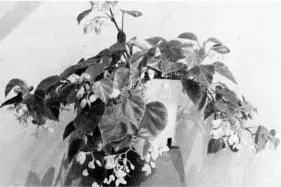Grown as easily as philodendron or ivy, B. solananthera is one of my favorite begonias. In late winter and early spring, the flowers are so fragrant they fill the whole greenhouse with perfume much like that of orange blossoms.
This Begonia was found in the wild in Brazil as long ago as 1859. It is classified as trailing and scandent (climbing). The heart-shaped green leaves are about two inches in length on trailing stems.
The heavy clusters of white flowers dangle from the leaf axils covering the plant. The centers of the flowers are red, hence the common name of “Brazilian heart.” As both male and female flowers are open at the same time, this plant can be self-pollinated easily to produce seed for the Seed Fund or to be shared with your friends.
When I first obtained my plant years ago, I had no room for hanging baskets and I grew it in a deep pot, raising it above the bench by placing it on an upturned pot. On the windowsill or under fluorescent lights, the pot is kept in a footed compote so the stems do not rest on tray or table.
As with cane-like begonias, the new leaf grown at the tip of each branch is pointed. Pinching out this unfurled new leaf encourages the plant to branch and fill in at the top of the pot or basket. This practice may be continued until the stems are long enough to suit you.
B. solananthera likes good light but needs to be protected from too much sun unless the sun in winter where you live is very weak. It thrives in the shaded greenhouse or window during summer.
This Begonia I have found grows happily in a variety of potting mixes as well as in any of the soilless mixes. As I use soil, sand, peat, dolomite, and bone meal in my potting mixes, I do not add additional fertilizer until the plant has become well established. At that time, I begin fertilizing twice a month through the growing season with one of the water-soluble fertilizers like Miracle Gro, Ra-Pid Gro or Plant Marvel. During winter, it gets an occasional feeding of six drops of Schultz Instant to a quart of water. If you use a soilless mix, constant feeding is needed.
If the root ball of B. solananthera becomes dry, the leaves will turn pale and assume a glassy appearance. This is your cue to give it a thorough soaking, then not to water again until the top of the mix feels dry. The plant needs be only very slightly moist during the chilly and dark days of winter. If the temperature in your plant room or greenhouse is low, too much water will cause rot. Plant food cannot be assimilated by roots of plants if the potting mix is very cold.
The time to take cuttings is immediately after flowering no later than early autumn. I like to place four or five cuttings close together, back-to back, in a 4-inch pot of propagating mix with leaves pointing outward. When a firm tug indicates roots have developed, feed half-strength fertilizer once a week until the pot is filled with roots. Then the entire mass may be removed and placed in a 6- or 8-inch basket or in a 6-inch pot.
I use plastic baskets with attached saucers in my greenhouse because I do not want water dripping on the plants on the bench. My friends Mildred and Edward Thompson prefer wire baskets lined with sheet moss.
Under fluorescent lights or in windows, it is best to grow B. solananthera in either plastic or clay pots placed inside decorative footed containers with a layer of gravel in the bottom. When growing plants this way, be sure to check frequently to be sure no water reaches the bottom of the pots for the roots of the plants rot if the pot is standing in water.
Keep in mind that this delightful species blooms in winter, indicating it needs a short day to initiate flower buds. If grown in a window, it should be kept in a little-used room where no lights are burning at night. When buds have developed, it may be brought into the dining or living room to be enjoyed.
If you are growing under lights, reduce the time the lights are burning to 10 hours beginning in late November.
After the buds have been set, the lights may be timed to burn 12 to 15 hours a day.


